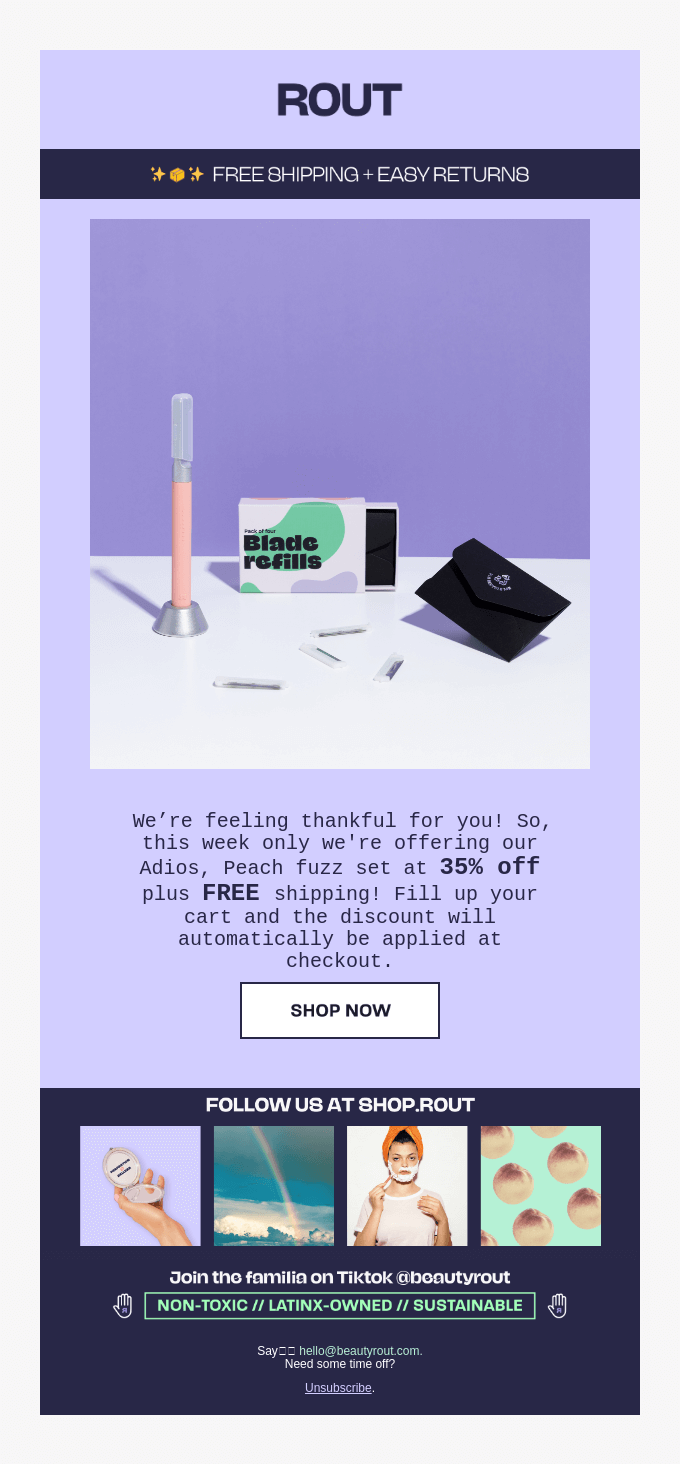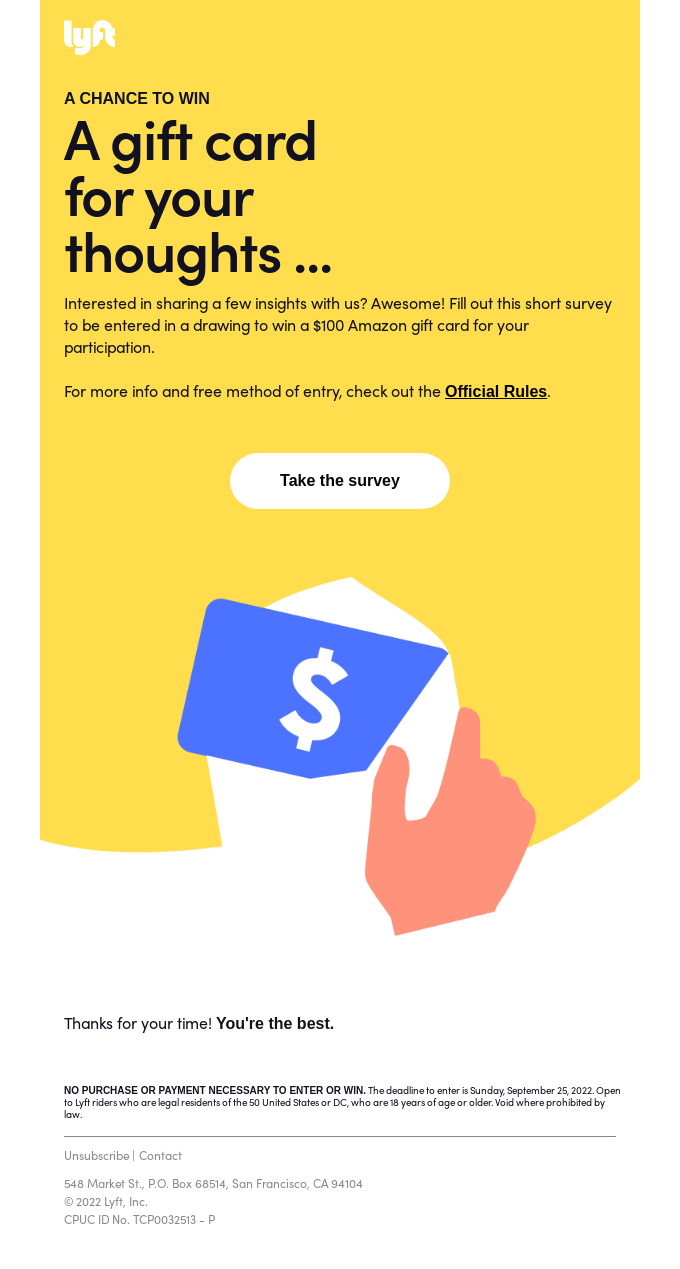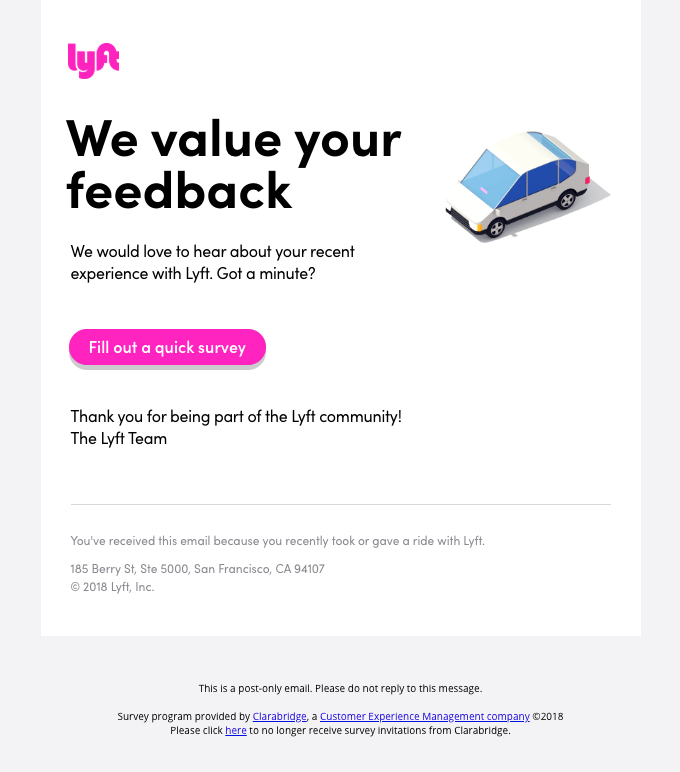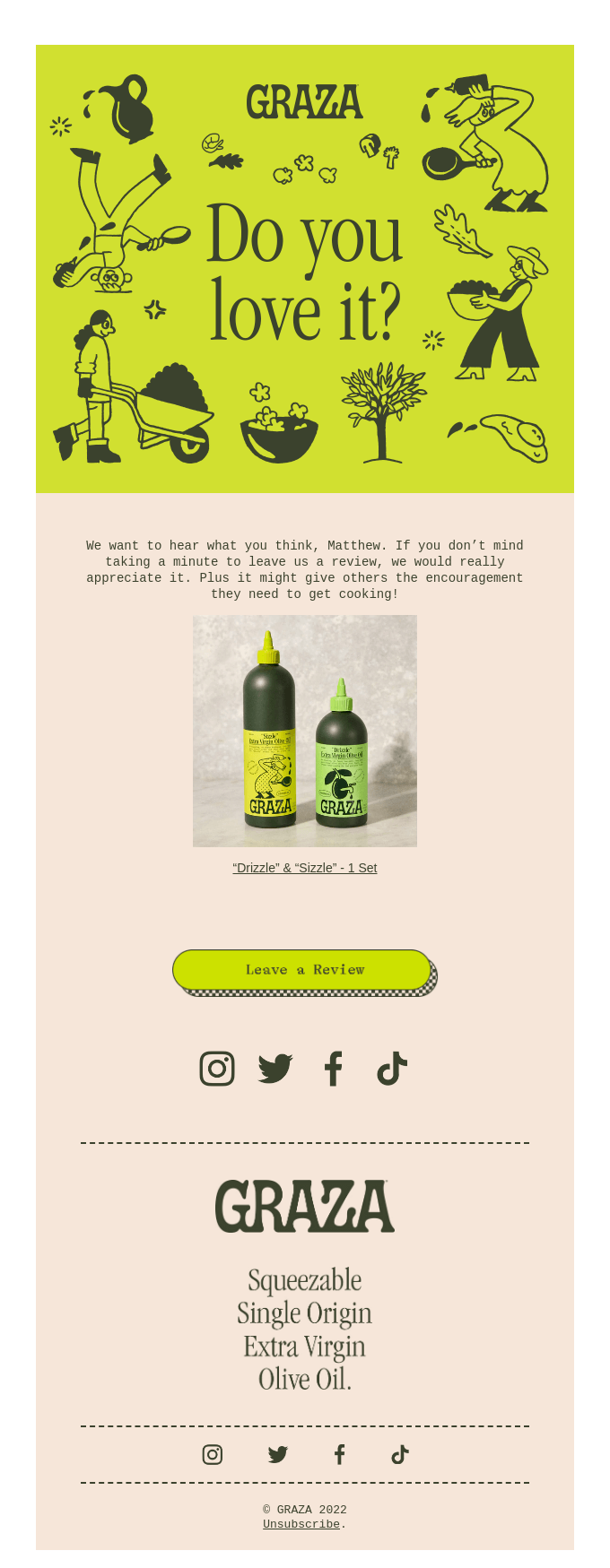[This blog was originally posted on November 22, 2021 and has been updated to showcase new examples]
If you’re planting your feet just now in the world of email marketing, believe us, you couldn’t have chosen a better time! Why? The answer is multifold, really. For starters, ever since the onset of the pandemic, the rate of email volume growth has swelled thrice as before. And despite that, there has been no fall whatsoever in email engagement rates. In a bid to keep their businesses relevant, brands have either been forced to adopt digital transformations or dial up their existing digital dependencies, thereby increasing their reliance on email to a great extent.
Thanks to its cost-effectiveness and incredibly high ROI, email has been the preferred channel for crafting digital interactions by businesses all across the globe. But, email marketing is not just about sending a pixel-perfect, cleverly written email to your customers and expecting the rewards to fall unbridled into your lap. Getting a customer onboard is one thing, but getting them to actually purchase from you is a different ball game altogether. Little can you afford to step back and relax after someone has signed up for your newsletter and communications; the real task begins now- periodically checking in with them, following up on their purchases, soliciting their feedback, and all. This is where follow up emails come into the picture. You need to know how to follow up on email to amplify the impact of your marketing campaigns.
Table of Contents:
- What Are Follow up Emails?
- Why Should You Send Follow up Emails?
- The Anatomy of A Perfect follow up Email
- Follow up Mistakes That Might Cost You Replies
- How To Write A follow up Email After Getting No Response
- Some follow up Templates To Get Your Ball Rolling
- Wrapping It Up
What Are Follow up Emails?
As is pretty evident by the name, follow up emails are those that businesses send to their customers or subscribers in response to their activities and actions. This could either be a single email or an entire sequence. Follow up emails serve a variety of purposes- they gather information, foster trust, establish your credibility, and drive conversions. Bottom line, the key objective behind sending an effective follow up email to clients is to generate business. In the process of checking in with their customers, brands actually attempt to unearth information that helps them resolve existing hurdles or learn new insights that could be implemented in their operations going forward.
All of this makes follow up emails pretty handy, right? Unfortunately, too many organizations out there completely miss the trick when it comes to crafting winning, action-inciting follow up emails. Often, follow up emails end up being too aggressive, repetitive, or just plain ineffective. They fail to provide the subscribers with immediate value, as a result of which they’re unable to capture their attention. And if a follow up email is going unread or unnoticed, then, well, you might as well kiss the chances of that particular product or service getting sold goodbye. People receive jillions of emails on a daily basis, and you can’t really blame them for looking past yours, should it happen to be as uninventive and redundant as the rest.`
The only surefire way of getting through to them is by writing follow up emails that:
- Address your customers’ most pressing pain points.
- Explain to them how your products or services could make a difference in their lives.
If you know for sure how to write a follow up email, you already hold an edge over your competitors.
To date, many business owners still hesitate at the prospect of sending follow up emails. They worry about bugging the customer and appearing overeager. And while that is not entirely irrational, it is about time that they learned to let go of this philosophy. Remember, an effective follow up email is the difference between a lost prospect and a closed deal at the end of the day.
Here are some of the most common reasons that hold back businesses from following up with their clients:
Fear of Seeming Desperate
Upholding your brand image is, of course, paramount to your company’s success, but not when it comes at the cost of you doing business. Most organizations fear that they’ll appear desperate or embarrass themselves by sending a follow up email, eventually hurting their brand reputation in the process. That only happens when you decide to disregard follow up etiquette completely. As long as you abide by it, there’s absolutely no chance of things going awry. Don’t spam your customers with follow up emails a few minutes or hours after sending them a welcome email; basically, don’t check in with them immediately after they have interacted with your brand. Allow them some breathing space. The rule of thumb is to wait for at least 2-3 days before sending a follow up.
Forgetting To follow up
Most businesses either don’t have a dedicated follow up strategy or are extremely casual when it comes to devising one. As a result, the prospect of checking in with clients post the initial interaction completely skips their minds. The impact of a single missed follow up might, at first, appear quite insignificant, but know that it could very well become the gateway for multiple missed business opportunities, should you fail to do anything about it. Hence, it is vital that you prioritize your follow ups. Set reminders, mark your calendars, and do everything possible in your power to ensure that you don’t miss a follow up.
Being Too Optimistic For Their Own Good
Your initial email was well-researched, engaging, laden with attractive visuals, and meticulously personalized. You test it for accessibility, ensure that it is mobile-optimized, and carry all routine checks before eventually sending it to your contacts. You’ve done everything possible from your end; now it’s the customers’ turn. However, a week passes by, and there’s not so much as a customary monosyllabic response from them. This troubles you, but you hesitate to follow up. You’re confident about your email; you left no stone unturned while developing it. Surely, the customer HAS to reply to it, right?
WRONG. Sorry to burst your bubble, but customers by and large across the globe tend to be extremely fickle. You might have invested every ounce of your time and energy into your emails, but that still doesn’t guarantee a response from your subscribers’ end. Amidst busy lifestyles and flooding inboxes, customers are bound to miss the odd email or two from you. Wait for 2-3 days, and if there’s still no response, don’t hesitate to shoot a follow up email. Don’t just sit hoping that they’ll reply eventually, one day.
Why Should You Send Follow up Emails?
Sales is a tricky channel to navigate. So much so that nearly 80% of sales require an average of five follow ups to effect a closure. In fact, only a meager 2% of sales are closed during the first point of contact. Simply put, if you’re shying away from sending out follow ups, you’re essentially foregoing all your revenue (and business!). Sounds terrifying, doesn’t it?
If you want to steer clear of this fate, embracing follow up email marketing is the only way out for you. Still not convinced that follow up emails are important? The following arguments will do the trick for you. Take a look:
- To make an impression on your audience, you need to be, first and foremost, visible to them. Follow up emails are your best bet at achieving that. More the visibility, the greater are the chances of you receiving a response. As a matter of fact, adding just one more follow up email increases your average reply rate by 11%. Follow up emails, in general, enjoy a higher reply rate. To that extent, the reply rate for the first follow up email is almost 40% higher than that for your first email. That is to say, if 10% of your new subscribers responded to the onboarding or welcome email, then almost 14% are assured to respond to your first follow up email.
- Follow ups allow you to create more opportunities to obtain a response from your subscribers. They only border on being intrusive and annoying when they’re worded ineffectively. The chart below illustrates how sending a greater number of emails correlates to higher response rates.
Don’t lose heart if your first email goes unanswered (and give up on the prospect). Instead, send a follow up mail. There’s a 21% chance that you’ll receive a reply to this. But improving response rates (and, by extension, conversions) are not the only things these emails accomplish.
- When composed in the right tone and delivered in the right frequency, follow up emails essentially tell your customers that you’re eager to learn more about their interests and opinions. Subsequently, this builds trust between you and your customers and endears your brand to them.
- Follow up emails are an excellent means of establishing credibility as well. Sending your buyers an email right after they have made a purchase goes a long way towards assuring them. A few weeks later, sending a post-purchase email (that solicits their feedback) lets them know that you care about them even beyond their transactions.
The best part? You can customize your follow ups too! So, the next time you send a re-engagement or reactivation mail to any of your customers, don’t make the draft generic. Add product recommendations and insights corresponding to their past purchases and buying patterns; this will force them to take an interest in your follow ups. In this way, follow up emails prove to be instrumental in shaping the customer experience.
The Anatomy of A Perfect Follow up Email
Nailing the recipe of a perfect follow up email is an uphill task. It involves multiple ingredients, and each has to be seasoned to perfection for the end product to be palatable. Wondering how to write THE follow up email? Here’s all you need to keep in mind!
Establish an Objective
The main reason why most follow up emails go unopened or get marked as spam is because they lack a clear objective. As mentioned earlier, a follow up email serves multiple purposes- gathering information, obtaining feedback, expressing gratitude, and the like. Accordingly, you can include a compelling CTA (call-to-action) in it that incites action from your buyers. Confused as to how you should define the objective of your follow up email?
Keep the following pointers in mind:
Ask For Information
First meetings with customers are mostly utilized in:
1. Gaining a fundamental idea about their buyer personas.
2. Sizing up the expectations they have from your brand.
And while that’s quite insightful, it certainly doesn’t tell you everything you need to know about them to deliver a flawless experience. Therefore, using a follow up email to build on your initial conversation is a great tactic. Ask them about something that might have skipped your mind during the initial conversation, or collect any additional information that you feel will be crucial towards shaping their experience. If you can’t figure out anything, simply ask them about the pain points they would like to be addressed by your products and services. That will surely earn you a response. When you’re transparent about your requirements, you not only eliminate the seed of doubt from their minds but also enable them to respond in a manner that is beneficial to both parties.
Schedule A Meeting
Your first conversation with the client has just wrapped up – you now understand their problem statement, their expectations, and what their idea of a successful solution is. The next course of action is to send them a follow up email, asking them to schedule another meeting with you. This meeting is for pitching them your services and products, explaining how you plan to address their issues, and how your brand is the most appropriate fit for their requirements. Follow up emails that request meetings must inform the customers about the objective of said meeting and the topics that will be discussed during it. This makes the email highly relevant (ergo, hard to ignore) for them.
Get A Status Update
When you approach a client for the first time, and they happen to turn you down, don’t remove them from your database altogether. Add them to your contacts list, keep an eye on their recent developments, and follow up with them periodically. No two days are the same for any business out there, and you never know when someone might need your assistance, even if it’s a client that had previously turned you down. And the only way you can make yourself wise to such requirements is by having a solid follow up strategy in place. Catching up with previously uninterested customers can be fairly tricky, however, and so you need to be absolutely spot on with the wording of these emails. For instance, you can’t just send them a generic “Hello! Are you still interested in taking our services?” month after month and expect them to engage with you. If you truly want to catch their attention, you need to send follow ups that are in line with their recent activities and which contain proposals they can seriously consider.
Express Your Gratitude
Follow up emails that express your gratitude to the customers go a long way towards fostering customer loyalty and enhancing brand reputation. Although it is worth noting here that these emails break convention from typical follow up emails. This is because most follow up emails are aimed at eliciting a response from customers. However, in the case of thank you emails, the primary objective is to leave your subscribers with a positive feeling about your brand. It might sound trivial at the outset, but a simple expression of gratitude might end up being the difference between an individual being a one-time or a recurring customer. So, what exactly should you thank your customers for? Besides them purchasing from you? Well, there are multiple occasions. You can thank them for:
- Leaving a positive review
- Providing you with a referral
- Participating in your survey
…and a bunch of other reasons!
Here are a few examples of some effective customer appreciation emails.
When you clearly define the objective of your follow up email, you are, in essence, providing some kind of immediate value to your customers. This, in turn, encourages them to engage with the content of your email and respond efficiently to the instructions you might have enclosed in it.
An excellent way to convey the objective of your follow up emails is by writing compelling and crisp subject lines. Given that the subject line is the first thing that a reader comes across while opening an email, you must attempt to give it as convincing a tone as possible.
Keep the following pointers while composing your subject lines:
- Always try to evoke a sense of urgency. Subject lines that convey urgency can increase your open rates by 22%. Moreover, emails having “tomorrow” in their subject lines were observed to have 10% higher open rates than those that didn’t.
- Use numbers in your subject lines. They never fail to garner attention.
- If possible, try to include an emoji in your subject line. Including a visual aspect significantly improves the probability of your email grabbing eyeballs.
Take a look at these examples to get some inspiration.
- Bellroy: Day 30. What’s happened so far? (Source)
- Apple: Get up to speed with a recap of the Apple Event. (Source)
- YNAB: Where’d ya go? (Source)
- Rock Candy Media: Do you know what you’re getting into? (Source)
- Uber: Did you know we’ve made big changes in the last year? (Source)
- Thousand Fell: Want to be a part of building a brighter future? ✨🌏 (Source)
Besides coming up with intriguing and clever subject lines, you should also aim to craft your preheader texts in a similar vein. Appearing directly after the subject line in the inbox, preheader texts let you build upon it, thereby providing more incentive to the readers to open their emails.
Start With Context
Your contact or client perhaps schedules scores and scores of meetings on a daily basis. Now, they might vaguely register the minutes of every meeting, but it’s certainly not possible for them to retain the various individuals and parties that were associated with them. So, how do you ensure that they recall it’s YOU while sending a follow up? Start with context. That’s the best way to send a follow up email.Highlight a key takeaway from the meeting, present a brief summary of the things you discussed or even something outside business that you feel will help them jog their memory (say, you both discussed a movie or a football match at length). In a nutshell, the follow up email should remind them who you are and also clearly mention why you’re following up. Failure to do so will result in your email hopping aboard the first train to oblivion.
Define Your Purpose
Unless your follow up email has a definitive purpose and is forthright with its intentions, you’ll have a tough time having your readers engage with it. Be very specific in your follow up emails. What do you wish to achieve through it? Are you looking to collect some information? Get a status update? Schedule another meeting? Offer a preliminary assessment of your client’s problem statement? Whatever might be the case, ensure that it is stated clearly in your email. In business (and in life), nothing fetches you more brownie points than transparency. By clearly stating the purpose of your follow up email, you’re essentially amplifying your sender reputation. This subsequently puts you in a better position to obtain the information you had set out to achieve in the first place.
Stay On Top of Your Frequency
If you can’t determine the correct time and the appropriate frequency with which to deliver your follow up emails, you won’t receive any fruitful returns even if you follow all the above instructions to the T. Although it is considered ideal to wait for 2-3 days before sending a follow up, this can largely vary depending on the situation at hand. If the first interaction you’ve had was a sale or a meeting, then you can consider getting back within the subsequent 24 hours itself to express your gratitude. On the other hand, if the interaction was a sales pitch or submission of important documentation, you might want to wait for around 48 hours before reaching out. If the first email was a request for scheduling a meeting, send the follow up after a week or so.
Follow up Mistakes That Might Cost You Replies
Creating an effective follow up email on your mind? Stay clear of these practices at all costs and prevent your follow up email campaign from getting derailed.
Do Not Make Your Emails Text-intensive
Human beings are highly visual creatures. Crafting follow up emails that are text-intensive, thus, will rob you of precious engagement and interaction. Irrespective of the context or objective of your follow up email, try to include relevant and high-quality images in it. If you have the resources, you can include videos, animation, and cinemagraphs; there’s no limitation.
This follow up message sample from Forever 21 perfectly illustrates how images spruce up your emails.
Do Not Compromise On The Copy
A clever, crisp, and to-the-point copy is an indispensable part of a follow up email. Keep in mind the fact that follow up emails have to be super specific, so don’t make your copies too lengthy. Align your email copy with your subject line and preheader text. Moreover, also take care that it complements the background image being used in the email. If there’s something that can be observed across all ineffective follow up email templates out there, it is the presence of repetitive and vague copies.
Take a look at these follow up email samples to understand how you can go about your copies.
Shy Away From Generic CTAs
Generic call-to-action texts like “Contact Us,” “Join Us,” “Free Trial,” “Read More,” and the like used to do the trick for businesses. However, modern-day customers are extremely sensitive to marketing campaigns, which means you need to be really inventive and quirky with your CTAs now to get their attention. If you are wondering how to send a follow up email that will definitely elicit a response from your subscribers, you must focus on designing CTAs that are simple, specific, and crafty. Take a leaf from the book of these follow up email templates.
Don’t Bombard Your Customers
As obvious as this tip might sound, you’d be surprised to know just how many brands fail to pay heed to it. Most follow up emails end up getting marked as spam for the same reason. Imagine this- You have approached a business for a particular requirement and scheduled a meeting for the same. Here, you share your problem statement and gather information about their products and services. You are unable to take a decision at the moment and wrap up the meeting, saying you need some time to evaluate their offerings. In the following 24 hours, they send 5-7 follow up emails your way, each inquiring about your final response. Wouldn’t that put you off? No matter how eager you are for a response, you must space out your follow ups rather than sending them all at once to your clients.
Don’t Make Your follow up Emails All About Yourself
In a bid to impress their subscribers, businesses more often than not end up talking a little too much about themselves in their follow up emails. And that’s where they lose customers. Remember, follow up emails are always about the customers and not you. Rather than launching into an endless monologue about the uniqueness of your solutions, tell your customers how your services can make their lives easier. Address issues that are relevant to them, and showcase how you can resolve them.
How To Write A Follow up Email After Getting No Response
The waiting period that follows after sending the first email is quite nerve-wracking. Sometimes, you’ll get a response, and at other times, you won’t. Here’s what you should do when the latter happens (someone has to break the silence, after all, right?).
Assess Your Closing Statements
“Let me know if there are any queries.”
“I’d love to hear more from you.”
“Hope we can catch up soon.”
All of these are examples of closing statements that should ideally be a part of your first email. A close is an intrinsic part of any follow up email format. Not only do they wrap up the current conversation, but they also lay the foundation for subsequent rounds of correspondence.
If you included a close in your first email, make them slightly more aggressive in your follow up emails. Phrase them such that your prospects will be forced to respond to them.
“Are you free for a meeting this Thursday?”
“Can I expect to hear back from you by next week?”
“Is there anything about the proposal you’d like to discuss in person?”
All of these closing statements have an actionable request that the reader needs to respond to. With every subsequent follow up email, adjust your close as per the situation’s demand at that juncture.
Maintain Professionalism
Keeping your calm and composure when you’re not getting any response to your emails can be very challenging; we understand that. However, that is still not a cue for you to keep your professionalism aside and send passive-aggressive follow ups your subscribers’ way. A single misstep can spell perpetual doom for your brand’s reputation. No matter how many times you’re made to follow up, always envelope your emails with positive intent. Let them know that you understand they might be busy, and then gently nudge them in the direction of composing a reply. If it still doesn’t work, rest assured that you’ve done everything possible from your end. Maybe it is time to move on from that particular prospect.
Keep Persisting, Don’t Cut Ties
What do you do with a customer who still refuses to write back to you after your sixth or seventh follow up? You chin up and brace yourself to write an eighth follow up. In the meanwhile, you’re always allowed to focus less on them and more on other exciting prospects. Just don’t cut ties with the unresponsive ones. Worse still, don’t send them an email explicitly stating that you wish to remove them from your contact list (however high the temptation maybe!). Send them a follow up email once every three or four months, but don’t stop reaching out to them.
Refrain From Misleading Subject Lines
Occasionally, businesses will use their subject lines to alert readers’ to non-existent meetings and phone calls that they had supposedly conducted with them, just to pique their curiosity. While this may cause them to open the email, they wouldn’t definitely bother to reply. A professional follow up email should never be used to trick your prospects to secure an open, no matter what. Always focus on building trust and establishing transparency with your clients. Only then can you expect a response.
Some Follow up Templates To Get Your Ball Rolling
When you’re new to the follow up game, it can be pretty tricky to ace the tone and the mood right from the get-go especially when it comes to B2B email marketing. Therefore, to give you a headstart, we’ve compiled over here a few business follow up email samples and other templates corresponding to different occasions. Feel free to help yourselves.
Post-event follow up
Hey <First Name>,
It was lovely running into you at the event. I took the liberty of checking out your company afterward and was really impressed by the kind of work you guys are doing. I also noticed that you are looking to diversify your operations by expanding into <field name>. My team and I have worked on multiple projects in that domain and were wondering whether we could assist you on this matter?
Let me know if we can meet up this weekend to discuss the same.
Once again, it was indeed a pleasure making your acquaintance at <event name>!
Cheers,
<Your signature>
Post-meeting follow up
Hey <First Name>
It was great getting to meet you in person today. The discussion was highly fruitful, and I believe both parties have a sound understanding of what is to follow in the times to come.
Attached herewith are the major takeaways from the meeting.
<Insert salient points of the meeting>
<Insert proposed plan of action>
<Mention possible agenda for future meeting>
I believe this summarizes what we discussed today. Looking forward to the next!
Thank You,
<Your signature>
Feedback Email
Hey <First Name>
How are you liking < product or service name> so far?
Can you spare a few moments to give feedback? It will help us in serving you better.
If you liked it, do you mind leaving a positive review on <website name>?
If you didn’t, please let us know what went wrong. We’re all ears.
Warm Regards,
<Your signature>
Following up After No Response
Hey <First Name>
Just checking in to see if everything’s alright at your end. I noticed you didn’t revert to the previous email, so I was wondering if there were any complications that I could help you out with?
I completely understand that you have a busy schedule, but I’d really appreciate it if you could spare some time to file your response.
Looking forward to hearing from you!
Cheers,
<Your signature>
Thank You Email
Hey <First Name>
Thank you for choosing <product name>.
We were delighted to be of help to you and hope that we can continue to do the same for you in the future too!
Yours truly,
<Your signature>
Wrapping It Up
Know that it is completely natural to feel a little overwhelmed by the prospect of follow up emails at first. Still, we’d urge you to look past the initial barrier and visualize what it holds in store for you in the long run- greater customer loyalty, more conversions, and enhanced brand reputation! Once you hunker down and seal your follow up strategy, there’s practically no looking back for you and your business.

















Rohan Kar
Latest posts by Rohan Kar (see all)
Boost Email Deliverability And Seal The Success Of Your Campaigns- A Comprehensive Guide To Email Whitelisting
HTML5 Display Banner Ads - 8 Best Practices Every Marketer Must Follow